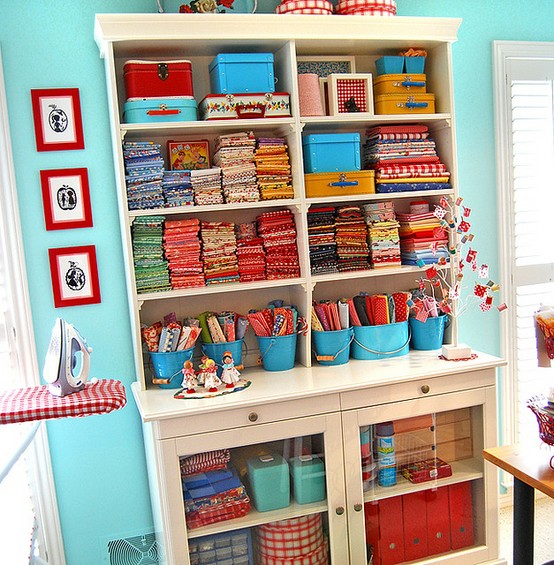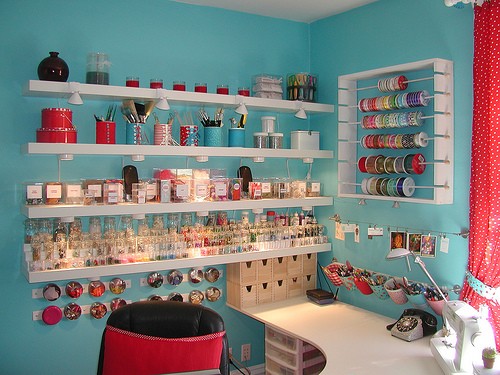Reasons Why I sew.
In the little House on the Prairie days, Ma stiched quilts for the winter. The great Depression made sewing a money-saving necessity. In the '50s, the Happy Homemaker sewed curtains and baby clothes because that was her job. But in the twenty-first century, sewing is no longer a required skill. Today, it's actually cheaper and faster to buy clothes from the Gap - especially if you count your valuable man-hours (or woman-hours). So why sew? Why do I wake up each morning excited to get to my machine and make something? Why do I spend each day spreading the crafty sewing gospel? Even though it's kind of like explaining why I love a clear blue sky, here is my boiled-down, subjective list of reason why I sew.
1/ I can to to the fabric store:
When I go into a fabric store, I'm in an altered state. I love to walk around and look at the colors, and voiles, I get to imagine all the possibilities. What to make net? What prints and tetures do I want to spend the next few days with? Do I want to snuggle down with a soft fluffy mohair? or maybe beat the winter blues with oversized pink florals? Am I feeling dotty? Every visit to the fabric store is like a good first date-filled with potential.
2/ I can crack the code
I can look at a garment or a beautiful handbag and firgure out how to make it myself. (This is easier than you think.) I can measure the sections and copy them, adding a seam allowance. I can take a shirt apart and use the pieces as a pattern.Once you know the basics of sewing, clothes shopping is a whole new experience. Bloomingdale's becomes a research library with books on hangers. You can axamine garment to get inspiration and ideas. You will find yourself saying, "Oh, I can make that-but I'd rather do it in a elegant pinstripe". Which lead me to my net reason...
3/ I can make what I really want, how i want.
I know what looks good on me. I know what colors and fabrics I like, If I want a pencil skirt in silver brocade, I can make it. If I want that skirt in five different colors and different weights for different reasons (which I do), I can do that, too. And since I am somewhere between a size 4 and size 6, I can tailor my pencil skirt to fit just right , instead of having to pick the lesser of two ill-fitting evils in the store. It's crazy to think all the different bodies out there can fit into one of a half-dozen sizes. I find it empowering (and flattering) to make my clothes fit properly.
4/ I can alter and repair clothes myseft
I don't' have to pay a tailor to hem my pants. I can shorten skirts and narrow jeans for free. I can buy vintage or thrift-store clothes and customize them to my heart's content. I just went to Anthropologie and rescued a perfectly cute lace dress with a broken zipper from the bargain bin. Ten bucks! Score! Alterations etend the life of clothes and give old clothes a new start. I think of it as my personal recycling program; clothes stay in my closet and out of the landfill.
Preparing your space
It's never too soon to start thinking about your work space. Whether you've inherited a sewing machine or you're getting one soon, start envisioning where you want to sew. Where is the magic going to happen? You know how athletes prepare for competition by picturing themselves running up the hill or swinging the golf club for a hole in one? It's helpful (and fun) to imagine your self cutting and pinning, stiching and pressing. How can you keep tools within reach? You'ill be sitting in one space for stretches of time; will you look out the window? Will you play music? Try on different mental versions of yourself in your sewing nook - it'll help you figure out your priorities.
Pick a Home Base
Take a look around your house or apartment. Is there a cozy out-of-the-way sport where your sewing machine can live? Can your work area be dedicated and available at all times? Or will you have to put things away between projects ? Do you mind seeing your work area or do you want to hide it away? These are questions to start asking yourself. And there's no one right answer. My workspace is a closet - I call it the closet command center - and it holds everything I need for sewing, plus I can shut the door when not at work. If a closet isn't available, a rice-paper screen or rolling rattan blind hung from the ceiling are smart and inexpensive ways to cordon off a corner or hallway to use as a small sewing studio.
Get Organized
Think of a handyman and his tool bench. think of a cook in the galley of a submarine. You want to get the greatest efficiency and ease out of your area. That means organizing your equipment and tools. Perhaps your equipment can be folded up or stashed away, or attached to the wall or the back of a door. Build-in shelving is fantastic-use shallow shelves for small storage jars, deeper ones for books and fabric. A small bookcase or filing cabinet works, too. Buy a pegboard, along with a pack of different-sized hooks, for hanging cutting and measuring tools so you can get at them easily. (Be sure to attach it to wall studes) A thread rack and bobbin organizer keep thread neat and visible. Put pattern pieces into large manila envelpes with the original packaging stapled to the outside; then place in magazine racks or vertical files and onto shelves. (Keep your project-in-process in a clear, zip-top bag on the pegboard) Smaller odds and ends like buttoons, snaps, and seam binding can live in old recycled jars, boxes, cans, or baskets.
Work space essentials
What you need for the special space you've picked out:
Cutting table
A sturdy, fairly high table (at least 30 48 x 36 inches) accessible from at least two sides. A tabletop with adjustable legs from IKEA works well.
Sewing table
A desk like table around 28 inches high. At least 6 inches of surface area on either side of the machine will give you room for your project, pincushion, and scissors while you're sewing.
Comfortable chair with a strong back
When you're sitting in the chair, the sewing machine should fell a little higher than a keyboard at a computer. You can adjust once you start working (sit on a cushion or try a lower chair) so you feel comfortable.
Ironing board and steam iron
The ironing board should be full-size.
Lost of shadow-free light
You need a task light for your work and overal light for the sewing area. Natural light is wonderful for sewing (especially for matching thread to fabric and other color-related tasks), but it's not always available, If you aim area lights to bounce off the walls or ceiling, the light spreads nicely and makes fewer shadows.
Read more? visit this book:
Some work space for your inspiration ^_^ - source image from pinterest.com
Now I am go to sew my first project - elastic pant. I will post this sewing tutorial soon. See you next post :)














No comments:
Post a Comment